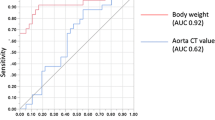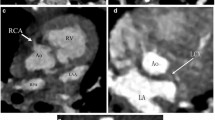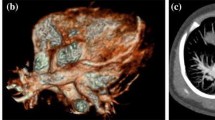Abstract
Background
As CT technology has advanced, techniques for pediatric cardiac CT in congenital heart disease have evolved from retrospective electrocardiography (ECG)-gating with relatively high radiation doses to lower-dose prospective ECG-gating and even single-beat gated scans. Despite these advances, coronary artery imaging in children remains challenging because of their small vessel size and high heart rates, often necessitating retrospective gating.
Objective
Evaluate coronary artery visualization in pediatric patients (<20 years) who underwent low-dose high-pitch ECG-triggered scans and stratify the probability of coronary artery visualization based upon heart rate and body surface area (BSA).
Materials and methods
Two hundred eleven high-pitch ECG-triggered studies from April 2014 to November 2017 were reviewed by two pediatric cardiac imagers in this retrospective study. Patient age, gender, BSA, average heart rate, heart rate variability and use of general anesthesia were recorded as well as dose–length product (DLP) and volumetric CT dose index (CTDIvol). We assessed the coronary artery score using a 5-point scale, with score of ≥3 considered of diagnostic quality. We performed multivariate statistical analysis including logistic regression to analyze effects of heart rate and BSA.
Results
Patient age range was 1 day to 19 years (median age 3 years). Heart rate range was 49–188 beats per minute (bpm; median 122 bpm) and BSA range was 0.15–2.07 m2 (median 0.53 m2). The origin and proximal coronary arteries were confidently seen (score ≥3) in 61% of studies in this cohort. Coronary artery visualization scores further increased with increased BSA (P<0.002) and with decreased heart rate (P<0.001). At heart rates <100 bpm or in patients with BSA>0.58, adequate coronary artery visualization was present 72% of the time.
Conclusion
While in many patients the coronary artery origins are visualized using high-pitch ECG-triggered technique, the importance of coronary artery visualization needs to be weighed with the radiation dose penalty in individual patients to achieve optimal imaging.


Similar content being viewed by others
References
Liu Y, Li J, Zhao H et al (2016) Image quality and radiation dose of dual-source CT cardiac angiography using prospective ECG-triggering technique in pediatric patients with congenital heart disease. J Cardiothorac Surg 11:47
Paul JF, Rohnean A, Elfassy E, Sigal-Cinqualbre A (2011) Radiation dose for thoracic and coronary step-and-shoot CT using a 128-slice dual-source machine in infants and small children with congenital heart disease. Pediatr Radiol 41:244–249
Goo HW, Yang DH (2010) Coronary artery visibility in free-breathing young children with congenital heart disease on cardiac 64-slice CT: dual-source ECG-triggered sequential scan vs. single-source non-ECG-synchronized spiral scan. Pediatr Radiol 40:1670–1680
Jin KN, Park EA, Shin CI et al (2010) Retrospective versus prospective ECG-gated dual-source CT in pediatric patients with congenital heart diseases: comparison of image quality and radiation dose. Int J Cardiovasc Imaging 26:63–73
Smettei OA, Sayed S, Al Habib AM et al (2018) Ultra-fast, low dose high-pitch (FLASH) versus prospectively-gated coronary computed tomography angiography: comparison of image quality and patient radiation exposure. J Saudi Heart Assoc 30:165–171
Feng R, Mao J, Liu X et al (2018) High-pitch coronary computed tomographic angiography using the third-generation dual-source computed tomography: initial experience in patients with high heart rate. J Comput Assist Tomogr 42:248–255
Bastarrika G, De Cecco CN, Arraiza M et al (2008) Dual-source CT for visualization of the coronary arteries in heart transplant patients with high heart rates. AJR Am J Roentgenol 191:448–454
Li T, Zhao S, Liu J et al (2017) Feasibility of high-pitch spiral dual-source CT angiography in children with complex congenital heart disease compared to retrospective-gated spiral acquisition. Clin Radiol 72:864–870
Guberina N, Suntharalingam S, Nassenstein K et al (2018) Verification of organ doses calculated by a dose monitoring software tool based on Monte Carlo simulation in thoracic CT protocols. Acta Radiol 59:322–326
Ben Saad M, Rohnean A, Sigal-Cinqualbre A et al (2009) Evaluation of image quality and radiation dose of thoracic and coronary dual-source CT in 110 infants with congenital heart disease. Pediatr Radiol 39:668–676
International Commission on Radiological Protection (2007) The 2007 recommendations of the International Commission on Radiological Protection. ICRP publication 103. Ann ICRP 37:1–332
Huang MP, Liang CH, Zhao ZJ et al (2011) Evaluation of image quality and radiation dose at prospective ECG-triggered axial 256-slice multi-detector CT in infants with congenital heart disease. Pediatr Radiol 41:858–866
Le Roy J, Vernhet Kovacsik H, Zarqane H et al (2019) Submillisievert multiphasic coronary computed tomography angiography for pediatric patients with congenital heart diseases. Circ Cardiovasc Imaging 12:e008348–e008348
Goo HW (2018) Identification of coronary artery anatomy on dual-source cardiac computed tomography before arterial switch operation in newborns and young infants: comparison with transthoracic echocardiography. Pediatr Radiol 48:176–185
Goo HW, Park IS, Ko JK et al (2005) Visibility of the origin and proximal course of coronary arteries on non-ECG-gated heart CT in patients with congenital heart disease. Pediatr Radiol 35:792–798
Kanie Y, Sato S, Tada A, Kanazawa S (2017) Image quality of coronary arteries on non-electrocardiography-gated high-pitch dual-source computed tomography in children with congenital heart disease. Pediatr Cardiol 38:1393–1399
Barrera CA, Otero HJ, White AM et al (2018) Depiction of the native coronary arteries during ECG-triggered high-pitch dual-source coronary computed tomography angiography in children: determinants of image quality. Clin Imaging 52:240–245
Author information
Authors and Affiliations
Corresponding author
Ethics declarations
Conflicts of interest
None
Additional information
Publisher’s note
Springer Nature remains neutral with regard to jurisdictional claims in published maps and institutional affiliations.
Rights and permissions
About this article
Cite this article
Malone, L.J., Olson, A., Barker, A.J. et al. Visualization of proximal coronary arteries on high-pitch electrocardiogram-triggered computed tomography in pediatric congenital heart disease: effects of heart rate and body surface area. Pediatr Radiol 50, 1375–1380 (2020). https://doi.org/10.1007/s00247-020-04730-0
Received:
Revised:
Accepted:
Published:
Issue Date:
DOI: https://doi.org/10.1007/s00247-020-04730-0




